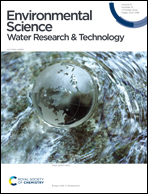Statistical and microbial analysis of bio-electrochemical sensors used for carbon monitoring at water resource recovery facilities†
Abstract
Water resource recovery facility (WRRF) operations personnel increasingly rely on sensor networks for automated control. Bio-electrochemical sensors (BESs), which leverage electrogenic biofilms to generate an amperometric signal of carbon metabolism, are being developed to monitor changes in wastewater composition and detect toxic shock events. This study presents for the first time, a long-term evaluation of a BES installed in the primary effluent channel of a WRRF for 247 days to quantify its sensitivity to organic load variations and assess the impact of abiotic factors on the BES response signal and biofilm composition, using advanced data analysis and microbial techniques. While the BES signal showed a strong correlation to volatile fatty acid (VFA) concentration, other environmental factors impacted the signal significantly. Principal component analysis identified pH, VFA concentration, and temperature to be the main contributors to the total variance of the signal in the entire dataset. 16S rRNA amplicon sequencing of samples obtained from the anodic biofilm of the biosensor determined Trichococcus and Lactococcus to be the dominant genera in the biofilm. While the precision of in situ carbon monitoring was impacted by environmental conditions, singular spectrum analysis of the biosensor signal identified four underlying cycles in the primary effluent (287, 92, 44, and 7 days). These results aligned closely with cycles identified in dissolved oxygen readings in an aeration basin downstream of the BES.

- This article is part of the themed collection: Data-intensive water systems management and operation


 Please wait while we load your content...
Please wait while we load your content...